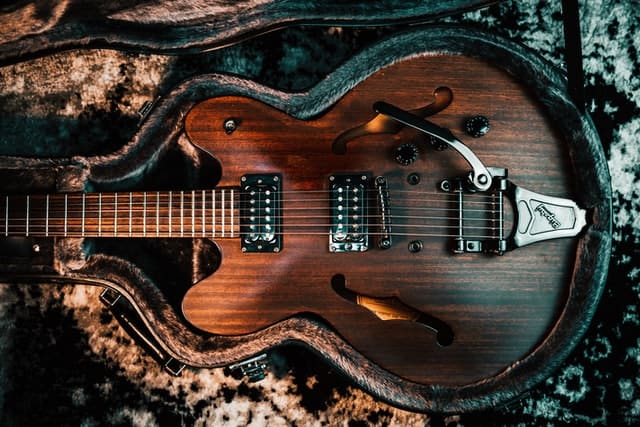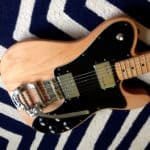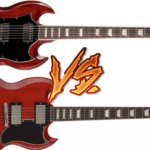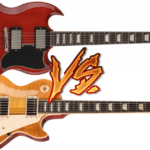Vibrato is a staple for many music genres.
And since the guitar was invented, players started looking for different ways of achieving it.
With time and ingenuity, there emerged a few different bridges and tailpieces that incorporated the effect into the zeitgeist.
Probably, the Bigsby is the most popular one, but you have probably also heard about the Maestro and the Vibrola.
Are they all the same? Which is best?
Bigsby, Maestro, and Vibrola are all different types of vibrato tailpieces. Bigsbys are the most popular. They offer a mellow slight vibrato effect. Maestros are similar in terms of sound, but with a slightly different mechanism. Vibrolas work completely differently and have tuning stability issues.
In this article, I’ll break down their features, functionalities, differences, and which types are better suited for which purposes.
In the end, I’ll give my final thoughts about them.
Bigsby main features
The Bigsby vibrato bar was developed by Paul Bigsby. The first Bigsby vibrato arm was invented in 1951. Fun fact: Paul Bigsby pioneered the first solid-body electric guitar.
The Bigsby vibrato unit’s lever arm is spring-loaded and is attached to a pivoting metal bar. The guitar strings are installed around said metal bar.
The tension of the spring counterbalances the tension of the strings when the unit is in the neutral position i.e. the bar is not being pushed down.
When the player pushes down on the bar, the strings loosen and the pitch of the strings is lowered. When the player releases the arm, the springs pull the unit back to the neutral position, thus raising the pitch.
The player can also pull up on the bar to raise the pitch of the strings.
Many guitarists can’t tell a noticeable difference in tone between a Bigsby vibrato unit and a non-Bigsby bridge. However, there are some who believe there’s less sustain on a Bigsby than on a non-Bigsby, as well as a cleaner sound.
They say this might have to do with the Bigsby causing the strings to rest further away from the pickups.
Since there are two sizes (and many models), a long and short Bigsby system, you could, theoretically, install a Bigsby on most guitars.
They can be found on many different guitar models and brands, but perhaps Gretsch is one of the manufacturers that choose to feature Bigsbys in most of their models.
Maestro main features
Gibson produced a vibrato tailpiece under the trade name Maestro Vibrola (more about Vibrola later).
A very simple setup, it’s a bent piece of metal that uses a spring-loaded system but they refer to it as a “bent steel string system”, which is an apt description in my opinion.
It’s similar to the Bigsby system in terms of the range you get when you go up or down with the bar.
You’ll often find them on ES-335 type guitars and, probably most famously, on Gibson SGs, with the most famous model being the Gibson SG Standard ‘61
You could put them on most guitars since the tailpiece doesn’t have to be long in order to work.
Vibrola main features
A man by the name of Doc Kauffman patented the first mechanical vibrola system in 1929. It was designed for Rickenbacker lap steel.
It operated differently than the hand-operated ones we know today: you moved the bar from side to side as opposed to up and down. Gibson later came up with their own hand-operated version called the Sideways Vibrola, which you are more likely to see today than the Vibrola Doc Kauffman patented.
It operates by pulling the bar upwards towards the ceiling/sky (it’s technically going sideways relative to the guitar) to lower the pitch and towards the ground to go up in pitch.
The Sideways Vibrola is notorious for not staying in tune very well but some players like having it on their guitars for aesthetic purposes as opposed to using it for vibrato.
It’s also rather heavy, which is another reason guitarists don’t often use it.
I’m not sure if the Sideways Vibrola would work on any guitar. The only guitar I was able to find where it was an option is the Gibson SG Standard ‘61.
Main differences between Bigsby, Maestro, and Vibrola systems
The Bigsby and Maestro operate quite similar to each other: they’re both spring-loaded and adjust pitch by going up and down in a mellow fashion.
The Sideways Vibrola is the outlier among these three because it goes side-to-side to alter the pitch.
The Maestro bar is skinnier than the Bigsby and the Sideways Vibrola.
Which one should you get?
I’m gonna start by saying you’ll probably not want to get a Sideways Vibrola unless you:
- Like the way it looks
- Want your guitar to be unnecessarily heavy
- Enjoy re-tuning your guitar multiple times per session
If you play rockabilly, you’ll want a Bigsby. It’s often found on hollow and semi-hollow bodies, which are a staple of rockabilly.
If you enjoy playing Gibson SGs, you’ll want a Maestro. They tend to look and operate best on SGs.
Keep in mind, if you play shred guitar and do a lot of divebombs, I wouldn’t get any of these options; I’d go with a Floyd rose for that.
Bigsby and Maestro work best when used sparingly. If used too much, you risk going out of tune.

Hello there, my name is Ramiro and I’ve been playing guitar for almost 20 years. I’m obsessed with everything gear-related and I thought it might be worth sharing it. From guitars, pedals, amps, and synths to studio gear and production tips, I hope you find what I post here useful, and I’ll try my best to keep it entertaining also.





